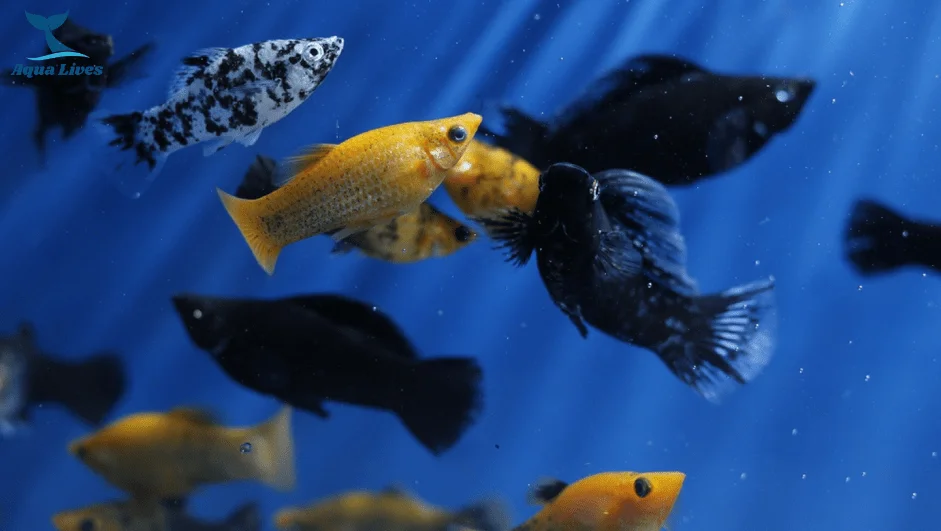Molly fish is popular aquarium pets known for their vibrant colors and friendly nature. These small, lively fish are native to freshwater rivers and Central and South American coastal areas. Their easy going temperament and ability to adapt to various water conditions make them an excellent choice for beginner and experienced fish keepers. With their striking appearance and active behavior, Mollies can bring color and excitement to any home aquarium. Now lets get to know this beautiful fish.
Molly Fish Habitat
Mollies are native to the warm, slow-moving rivers and coastal areas of Central and South America. They thrive in environments rich with vegetation and hiding spots. They prefer calm waters with plenty of plants that offer food and shelter. Can also be found in freshwater and salty environments in the wild, showcasing their adaptability. When setting up an aquarium for mollies, it’s essential to recreate these conditions with a well-planted tank and stable water parameters to ensure their health and happiness.
Mollies Appearance
These fish come in vibrant colors, ranging from bold oranges and fiery reds to calming yellows and elegant blacks. Their color variations add a splash of beauty to any aquarium. In terms of body shape and size, mollies typically have a streamlined and elongated body, with some variations across different types. They are generally small to medium-sized fish, making them suitable for various tank sizes. With their graceful appearance and captivating colors, mollies are a delightful addition to any freshwater aquarium.
Male and Female Molly Fish:
Male Molly fish:
- Size and Shape: Smaller and slimmer.
- Color: Brighter and more colorful.
- Anal Fin: Pointed and rod-like.
- Behavior: More active and often chases females.
Female Molly Fish:
- Size and Shape: Larger and rounder, especially when pregnant.
- Color: Less colorful but still pretty.
- Anal Fin: Fan-shaped.
- Behavior: Calmer and less aggressive.
Molly Fish Size:
They typically range in size from 3.2 to 4.8 inches (8 to 12 cm) when fully grown, depending on the species and gender. Males tend to be slightly slimmer and smaller than females. Sailfin mollies can grow slightly larger, reaching up to 6 inches (15 cm) in length or even larger.
Behavior
Mollies are known for their peaceful temperament, making them excellent community tank inhabitants. They generally get along well with other fish species, although they may display occasional territorial behavior, especially during breeding. Their activity level is typically moderate, with molliies often seen swimming gracefully around the tank or exploring their surroundings. They may also engage in playful behavior, such as chasing each other or investigating tank decorations. Overall, They are friendly creatures that can contribute to a lively and harmonious aquarium environment.
The Types of Molly Fish:
Common Molly (Poecilia sphenops): This is the standard variety of molly, known for its versatility and availability in various colors.
Sailfin Molly (Poecilia latipinna): Characterized by its large, sail-like dorsal fin, the sailfin molly is a striking variety often found in freshwater aquariums.
Black Molly (Poecilia sphenops): As the name suggests, this molly variety is entirely black, including its body, fins, and eyes, adding a bold contrast to any tank.
Dalmatian Molly (Poecilia latipinna): Like its canine namesake, the Dalmatian Molly fish features a speckled pattern on its body, typically black spots on a lighter background. This adds a unique touch to aquariums.
Colors of Mollies
They come in many pretty colors and patterns. Here are some common ones:
- Black Molly: All black.
- Silver Molly: Shiny silver.
- Gold Dust Molly: Yellow with black spots.
- Dalmatian Molly: White with black spots, like a Dalmatian dog.
- Marble Molly: A mix of black, white, and sometimes orange, like marble.
- Lyretail Molly: Any color with a forked tail.
- Sailfin Molly: Any color with a big, sail-like top fin.
- Balloon Molly Fish: Usually silver, gold, or black with a round belly.
- Platinum Molly: Bright silver-white
Common Diseases in Molly Fish
- Ich (White Spot Disease): Ich is caused by a parasite and shows up as small white spots on the fish’s body, fins, and gills. It can make fish scratch against objects.
- Treatment: Raise the water temperature slightly and add aquarium salt or a special ich treatment from the pet store.
- Fin Rot: Fin rot is a bacterial infection that causes the fins to look frayed or discolored. It usually happens due to poor water quality.
- Treatment: Improve water quality and use antibacterial medication.
- Swim Bladder Disease: This disease affects the fish’s ability to swim properly, causing them to float upside down or struggle to maintain their position.
- Treatment: Feed peas (with the skin removed) and ensure the fish gets a balanced diet.
- Fungus: Appears as white, cotton-like growths on the fish’s body. It’s often caused by poor water conditions or injuries.
- Treatment: Use antifungal medication and keep the water clean.
- poor water quality: is a primary factor contributing to many of these conditions.
- Treatment: Regular water changes, good filtration, and maintaining water parameters are key to preventing these diseases in the first place.
Molly fish Care
When caring for the fish, it’s essential to consider their tank size and setup, water quality, and temperature preferences.
Tank Requirement
- Tank Size: Provide at least a 20-gallon tank for a small group of mollies. They need space to explore and swim.
- Molly fish Water Temperature and Condition: Keep the water temperature between 72-78°F (22-26°C) and maintain a pH level of 7.5-8.5 as Mollies thrive in slightly warm water.
- Filtration: Use a quality filter to keep the water clean. Mollies prefer well-oxygenated water.
- Tank Mates: Choose peaceful fish that get along well with mollies. Avoid aggressive species.
- Plants and Decorations: Add live plants and decorations for hiding spots and enrichment.
- Regular Maintenance: Perform regular water changes (about 25% weekly) and test the water regularly for parameters like pH, ammonia, nitrite, and nitrate levels to keep the environment healthy.
- Stress Reduction: Minimize stress by avoiding overcrowding and providing plenty of hiding spots. Stress can lead to health issues like disease outbreaks or reduced immune function.
- Quarantine New Fish: Before adding new fish to your aquarium, quarantine them for a few weeks to prevent the spread of diseases.
- Health Monitoring: Watch for signs of illness, like changes in behavior, appetite, or appearance, and treat any issues promptly.
Molly Fish Tank Mates
When choosing tank mates for the fish, it’s important to select species that are peaceful and have similar water requirements. Mollies do best in schools (groups of at least 3 to 5 fish). Here are some suitable tank mates for the fish:
- Platies: Like mollies, platies are livebearers and have similar care needs. They are peaceful and come in various colors.
- Guppies: Another livebearer, guppies are small, colorful, and peaceful, making them excellent companions for mollies.
- Swordtails: These fish are closely related to mollies and share similar water conditions. They are also peaceful and colorful.
- Tetras: Small, peaceful tetras like neon tetras, cardinal tetras, and black skirt tetras can make good tank mates.
- Corydoras Catfish: These bottom-dwelling fish are peaceful and help keep the tank clean by eating leftover food.
- Dwarf Gouramis: These fish are generally peaceful and can add some interesting behavior and color to the tank.
- Rasboras: Harlequin rasboras and other similar species are peaceful and compatible with mollies.
Note: Always monitor the tank for any signs of aggression or stress, and ensure there is enough space and hiding spots for all inhabitants.
Molly Fish lifespan
They, commonly kept in home aquariums, generally have a lifespan of about 3 to 5 years. This lifespan can vary depending on factors such as the specific species of molly, tank conditions, diet, and overall care. Well cared mollies can grow up to 6 years in optimal conditions.
Molly fish food
Mollies have an easy-to-please palate as they’re omnivores, meaning they enjoy plant- and animal-based foods. In captivity, providing them with a balanced diet is important to keep them healthy. Their main meals usually consist of flake or pellet food, which gives them all the essential nutrients they need. Adding treats like bloodworms or brine shrimp adds variety to the food. For a more natural touch, you can also offer them blanched spinach or zucchini, which provides fibre and extra vitamins. By offering a diverse menu, you can ensure your fish stay healthy and maintain their vibrant colors in your aquarium.
Molly fish breeding
Molly reproduction is a fascinating aspect of these freshwater fish’s lives. Female mollies are livebearers same as their cousins Platy fish and Guppies, meaning they give birth to live fry instead of laying eggs. When a male molly fertilizes the eggs inside the female, she carries the developing fry in her body until they are ready to be born. This process usually takes about four weeks, during which the female’s abdomen visibly swells as the fry grows inside her. Once the fry is fully developed, the female releases them into the water, where they begin their journey to independence. Watching molly fish pregnancy cycle in your aquarium can be an exciting and rewarding experience!
Females can store sperm for several months after mating, meaning they can give birth multiple times without mating again.
Summary:
These fish are a great choice for any home aquarium. Their bright colors and friendly nature make them a joy to watch. Whether you’re new to keeping fish or have experience, molly fish care is easy and get along well with other fish. Just make sure to provide a well-planted tank with clean, stable water and a balanced diet to keep them healthy. Watch out for common diseases and take steps to keep the tank environment clean and stress-free.

